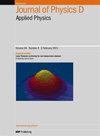纳米结构 Ni3Al 在低温下的电传输
IF 3.2
3区 物理与天体物理
Q2 PHYSICS, APPLIED
引用次数: 0
摘要
纳米结构镍3Al的电阻率完全由带有自旋波动的电子磁子散射主导,并在居里温度以下和居里温度以上以T5/3和T3/2的形式演化。除了在γ′-Ni3Al 纳米相中掺杂之外,过量的镍原子还聚集在 Ni3Al 的核中,从而使一些γ-Ni 纳米相嵌入到γ′-Ni3Al 纳米相中,形成核/壳纳米结构。γ′-Ni3Al纳米相中的巡回电子被进一步认为会在γ-Ni和γ′-Ni3Al纳米相中的声子周围游荡,以屏蔽电子-声子相互作用。因此,传导电子在很大程度上被γ′-Ni3Al壳中的自旋波动所散射,从而抑制了声子对纳米结构Ni3Al中电子传输的贡献。本文章由计算机程序翻译,如有差异,请以英文原文为准。
Electrical transport in nanostructured Ni3Al at low temperatures
The electrical resistivity in nanostructured Ni3Al has been discriminated to be dominated fully by the electron-magnon scattering with spin fluctuations and evolve in the form of T
5/ 3 and T
3/ 2 below and above its Curie temperature. In addition to doping into γ ′-Ni3Al nanophases, excessive Ni atoms are demonstrated to aggregate at the cores of Ni3Al so that some γ -Ni nanophases are embedded in the γ ′-Ni3Al ones for forming the core/shell nanostructure. The itinerant electrons from γ ′-Ni3Al nanophases is further suggested to wander around the phonons in both γ -Ni and γ ′-Ni3Al nanophases for screening the electron-phonon interactions. Consequently, the conduction electrons are scattered largely by spin fluctuations in γ ′-Ni3Al shells to suppress the contribution of phonons to the electron transport in nanostructured Ni3Al.
求助全文
通过发布文献求助,成功后即可免费获取论文全文。
去求助
来源期刊
CiteScore
6.80
自引率
8.80%
发文量
835
审稿时长
2.1 months
期刊介绍:
This journal is concerned with all aspects of applied physics research, from biophysics, magnetism, plasmas and semiconductors to the structure and properties of matter.

 求助内容:
求助内容: 应助结果提醒方式:
应助结果提醒方式:


